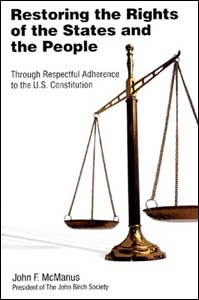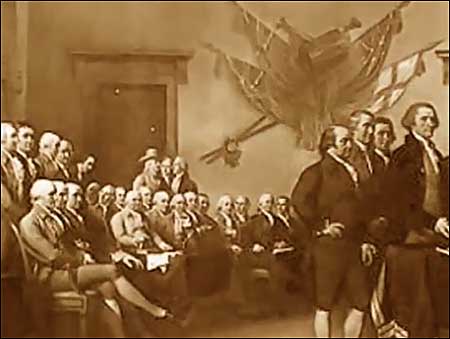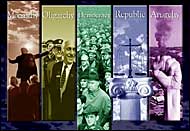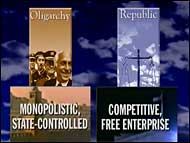Legislative Issues for Creating Political Change
by Edward Ulrich, updated September 23, 2022

.
This article explains legislative issues concerning creating political change, including summarizing the process of how a bill becomes a law; explaining the major political systems being used in the world today; explaining issues of United States politicians being loyal to political backers; explaining how the governmental system of the United States has migrated away from its original Constitutional principals; and explaining the public’s general lack of knowledge about the activities of Congress.
This page is part of the article Creating Political Change Through Communication and Legislation.
Article Notes
new:
September 23, 2022 - Text of the article has been updated.
Jump to parts of this page ..
A summary of the process of how a bill becomes a law
Issues with politicians being loyal to financial backers such as special interest groups and political action committees
Article Excerpt: A Summary of the Documentary Video “Overview of America”
Article Excerpt: A Summary of the Booklet “Restoring the Rights of the States and the People”
Issues with the lack of public knowledge about the activities of Congress
Issues with politicians being loyal to financial backers such as special interest groups and political action committees
Article Excerpt: A Summary of the Documentary Video “Overview of America”
Article Excerpt: A Summary of the Booklet “Restoring the Rights of the States and the People”
Issues with the lack of public knowledge about the activities of Congress
A summary of the process of how a bill becomes a law
— Every bill starts out as an idea that is sponsored by a Senator who introduces it as a bill. A bill can be introduced into either the Senate or the House of Representatives. The Senate is made up of two elected Senators from each state, and the House of Representatives is made up of over 435 elected representatives, the number coming from each state being determined based on the population of that state.
— Once the bill is introduced, it will be sent to a committee of pre-selected members of Congress which specialize in one issue, such as Agriculture, Energy, and Banking. Once the bill is debated, modified, and approved by a particular committee, it can continue to the full house.
— Once the bill is approved by a committee, it is then introduced into either the full House of Representatives or Senate where the members may discuss, debate, and then vote on the bill. If more than half of the Senators approve the bill, then it goes to the other house of Congress. If the bill is not approved, it can either be sent back to the committee or it can be abandoned.
— Once the bill has passed one particular house of Congress, it is sent to the other house where the same process of approval by committee, debate, and vote by the full house takes place. If more than half of those Senators vote in favor of the bill, it passes and is then sent to the President to sign. If the president signs the bill, it becomes a law. If the President vetoes the bill, it is sent back to Congress where it can either be changed to suit the President’s liking, or the veto can be overridden by two-thirds of both Houses of Senate.
View a directory of House Committees | View a directory of Senate Committees
Schoolhouse Rock - How a Bill Becomes a Law
View a classic animated short video showing the process of how a bill becomes a law.
View a classic animated short video showing the process of how a bill becomes a law.
Issues with politicians being loyal to financial backers such as special interest groups and political action committees
The corrupting influence of Lobbyists, Political Action Committees, and Earmarks
Members of Congress often rely on taking money from lobbyists and political action committees (PACs.) This is a problem because politicians are then indebted for favors to those organizations who have contributed to their campaigns.
Some politicians pledge not to accept money from lobbyists and PACs, however this puts those politicians at a disadvantage due to the fact that it deprives them from campaigning resources which their competitors collect, and public knowledge of the corrupting effects of lobbyist and PAC contributions is not widespread enough to translate into enough votes to offset the competitor’s advantage. Also, many politicians accept money from dishonest means yet still attempt to win votes by making campaign claims of not doing so.
“Earmarks” allow members of Congress to decide who gets money spent by the United States Government, and often members of Congress divert such money intended for the public’s benefit to political donors and “pork-barrel” projects.
running time 50 minutes
The Carlisle Group is a massive “private equity firm” that raises money from wealthy individuals and companies, where it then reinvests the money into private defense companies that have extremely high profit margins. It is made up of well known politicians such as George Bush Sr. and James Baker, and it is one of the most powerful elements of the “military industrial complex”— which is a business built around the defense industry that is so large and powerful that it is able to influence the politics of war. This video explains the structure of the group and it explains its history of abuses.
Campaign Reform
If campaign reforms are not created by way of legislation, those candidates who attempt to voluntarily be ethical in their actions are put at a competitive disadvantage by not having the same campaign resources that their competitors have. Some states are now enacting “clean election” laws that help to eliminate the influence of special interest groups. The organization Public Campaign advocates to reform and reduce the role of special interest money in state and federal elections.
Article Excerpt: A Summary of the Documentary Video “Overview of America”
A still image from the video documentary “Overview of America.”
This video describes aspects of the major types of government and economic systems that exist in the world, and it explains why the system of a capitalistic constitutional republic as outlined in the United States Constitution is preferable to other types of systems.
This video had been produced by The John Birch Society. Also see the article A Summary of the Booklet “Restoring the Rights of the States and the People”.
View the Article Page for This Documentary >>
A still image from the video documentary “Overview of America.”
This video describes aspects of the major types of government and economic systems that exist in the world, and it explains why the system of a capitalistic constitutional republic as outlined in the United States Constitution is preferable to other types of systems.
This video had been produced by The John Birch Society. Also see the article A Summary of the Booklet “Restoring the Rights of the States and the People”.
View the Article Page for This Documentary >>
running time 15 minutes
This video clip from the documentary video “Overview of America” describes the major types of systems of government that exist in the world— being “monarchy” meaning rule by one, “oligarchy” meaning rule by a few, “democracy” meaning rule by a majority, “republic” meaning rule by law, and “anarchy” meaning rule by none. The the United States was designed to be a “republic” by the Framers of the Constitution, and this video explains why that system is preferable to the others.
running time 11 minutes
This video clip from the documentary video “Overview of America” explains differences between the major economic systems of free market Capitalism, Fascism, Nazism, Socialism, and Communism. It is explained that all types of economic systems include elements of “capital” and “property,” with the differences between the systems being varying combinations of types of ownership and control of those two elements.
Article Excerpt: A Summary of the Booklet “Restoring the Rights of the States and the People”

[Note: September 23, 2022— I have updated the link to purchase the booklet.]
The 38 page booklet “Restoring the Rights of the States and the People” explains how the political system of the United States has migrated away from following the structure that has been specified in the U.S. Constitution, and it explains how elements of the current political system could be moved toward being restored to their original Constitutional principals.
The governmental system of United States was originally designed by the Framers of the U.S. Constitution to be a union of independent states, with most of the power belonging to the individual states, and with the Federal Government being intentionally very limited in its powers.
The political configuration of the United States currently consists of much of its power resting in a centralized Federal Government, which is a configuration that the Framers were strongly opposed to and went to great lengths to limit through the laws they created in the Constitution.
The booklet explains major points in the history of the U.S. government’s migration from its originally designed configuration in 1787 to how it is configured today, explaining the rationalized excuses and illegal methods that have been used by elements of the political system of the United States in order to implement legislation that is contrary to the laws and intentions of the Framers of the Constitution.
Methods are then described that can be used by citizens and politicians to move the government toward restoring key elements of its originally planned configuration as laid out by the Founders.
This booklet has been written by John McManus, and is distributed by The John Birch Society.
[Editor's Note, updated September 19, 2022— This booklet is very informative about the differences between how the U.S. Constitution has been specified and how American society is structured today. Major socialist agendas have been implemented in the United States during the past two centuries which exist contrary to the specifications of the Constitution. Many of such agendas are pointed to as being helpful for society, and it is true that some have been helpful, however those agendas have been implemented by making use of dishonest interpretations of the Constitution at the expense of such goals being reached by better methods. Often it is shown that such implementations contain deceptive and dangerous ulterior motives that are designed to ultimately destroy the sovereignty of the United States in order to empower a tyrannical one world government.]
Also view the documentary video Overview of America.
View the full article page >>

Restoring the Rights of the States and the People, by John McManus
[Note: September 23, 2022— I have updated the link to purchase the booklet.]
The 38 page booklet “Restoring the Rights of the States and the People” explains how the political system of the United States has migrated away from following the structure that has been specified in the U.S. Constitution, and it explains how elements of the current political system could be moved toward being restored to their original Constitutional principals.
The governmental system of United States was originally designed by the Framers of the U.S. Constitution to be a union of independent states, with most of the power belonging to the individual states, and with the Federal Government being intentionally very limited in its powers.
The political configuration of the United States currently consists of much of its power resting in a centralized Federal Government, which is a configuration that the Framers were strongly opposed to and went to great lengths to limit through the laws they created in the Constitution.
The booklet explains major points in the history of the U.S. government’s migration from its originally designed configuration in 1787 to how it is configured today, explaining the rationalized excuses and illegal methods that have been used by elements of the political system of the United States in order to implement legislation that is contrary to the laws and intentions of the Framers of the Constitution.
Methods are then described that can be used by citizens and politicians to move the government toward restoring key elements of its originally planned configuration as laid out by the Founders.
This booklet has been written by John McManus, and is distributed by The John Birch Society.
[Editor's Note, updated September 19, 2022— This booklet is very informative about the differences between how the U.S. Constitution has been specified and how American society is structured today. Major socialist agendas have been implemented in the United States during the past two centuries which exist contrary to the specifications of the Constitution. Many of such agendas are pointed to as being helpful for society, and it is true that some have been helpful, however those agendas have been implemented by making use of dishonest interpretations of the Constitution at the expense of such goals being reached by better methods. Often it is shown that such implementations contain deceptive and dangerous ulterior motives that are designed to ultimately destroy the sovereignty of the United States in order to empower a tyrannical one world government.]
Also view the documentary video Overview of America.
View the full article page >>
Issues with the lack of public knowledge about the activities of Congress
Members of Congress escape accountability and take unethical liberties due to their constituents not being aware of their true agendas.
Lack of transparency about the activities of members of Congress and ways of circumventing the problem
Even with increased media and activist attention, much of the activities of members of Congress would remain a mystery. A solution to this problem is to increase the transparency of the actions of people in Congress through making their activities public through changes in the law and rules of Congress. This could involve making members of Congress be required to post weekly updates of their activities including campaign contributions, meetings with registered lobbyists, their latest earmark requests and significant changes to their personal wealth, as suggested by the organization Fix Congress First.
Lack of mainstream media coverage about the activities of Congress and ways of circumventing the problem
Mainstream media outlets rarely mention the daily activities of Congress in ways that are understandable to most people. This could be fixed by such outlets incorporating quick daily information about the activities of Congress including issues concerning upcoming bills that are explained in layman’s terms. Media outlets would need to be pressured into doing so because increased public knowledge about the daily activities of Congress would conflict with the agendas of the people who control the decisions of the media.
Article Tree
| Creating Political Change Through Communication and Legislation |
| Legislative Issues for Creating Political Change |












